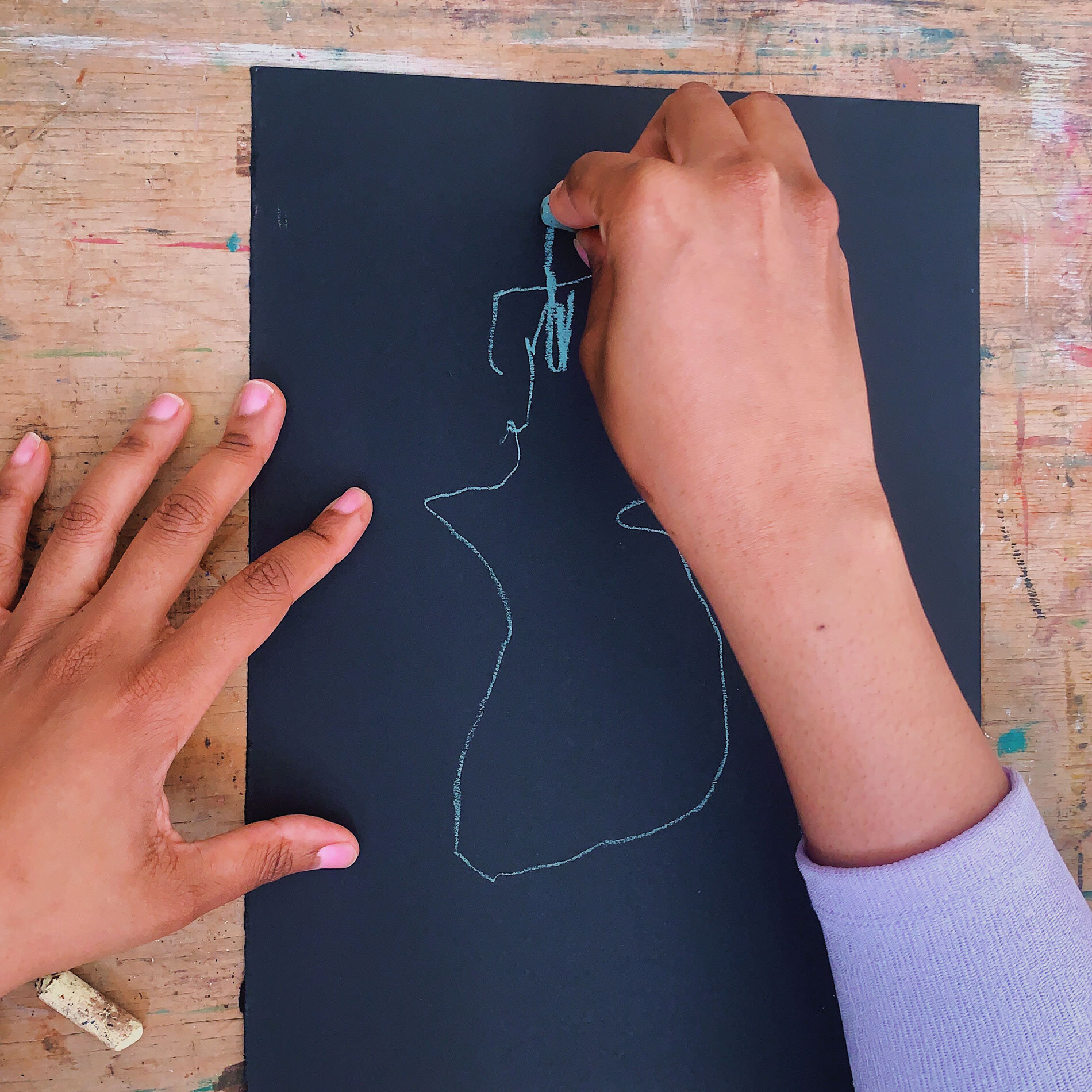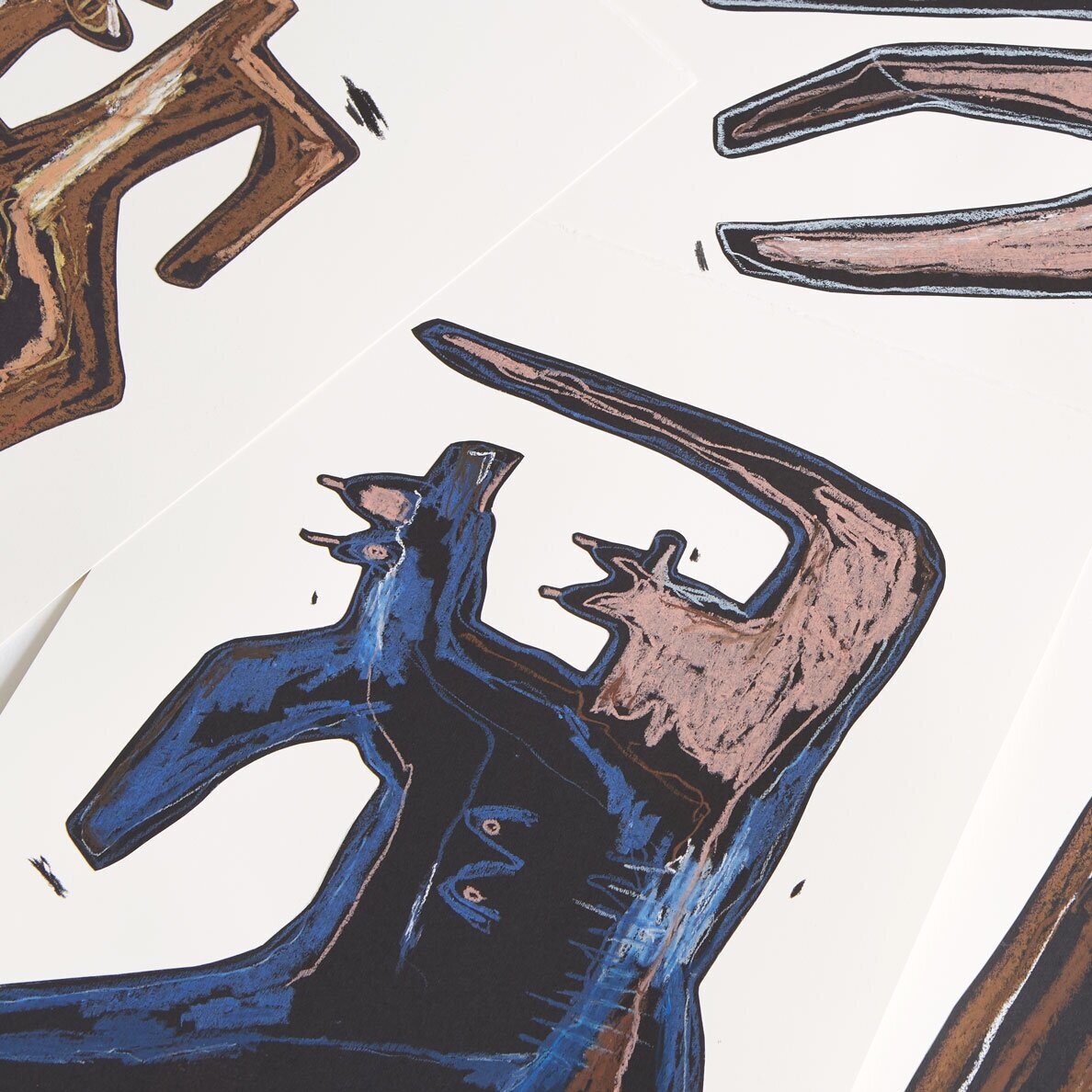London artist Siphiwe Mnguni navigates identity and family ties through abstract portraits
London-based British-Zimbabwean artist Siphiwe Mnguni creates figurative works centred on the iconography of black women and her own lived experiences. As a multidisciplinary creative and photographer, she combines a range of techniques including drawing, hand-cut collage and textiles to create vibrant mixed-media portraits layered with texture and mark-making. Her work often explores the artist’s personal relationships with her body, identity and immediate family through abstract depictions of the characters and memories that occupy her life.
Mnguni’s most recent series of works Gummed Together looks at the dynamics and expectations she experienced whilst growing up in a large immigrant family. Featuring six original pieces, the latest collection explores the artist’s attachments with loved ones whilst claiming her own individuality.
“As an artist, I make work foremost for myself. As a cathartic release. Then secondarily for the kids who look like me and are from a lower socio-economic background who might have no clue that it is possible. I want my work to inspire others to explore themselves and their mental wellness. Fundamentally, I want to bring joy.”
Born and bred in southeast London, Mnguni reveals how her Mother played an influential role in her introduction to creativity. She remembers watching her Mum paint and create work as an artist herself, but explains how time spent at her parent’s fashion manufacturing studio ignited her curiosity for textiles and collage. Although initially wanting to pursue a career in fashion, she later realised it was the drawing, mark-making and combination of materials she wanted to further explore.
“She would literally prop me up on her massive cutting room table and tell me to cut these patterns up for major designers. Maybe that’s where my obsession with hand collage comes from.”
“I did always want to be an artist, but I thought it would be in fashion. I loved the glamour of fashion, particularly the destruction of fabrics and surfaces. I was obsessed with Zandra Rhodes and her use of vibrant pinks and bold brush marks on silkscreen prints. I thought textiles would be the perfect suit.”
“I realised during my internship with fine artist Sarah Dwyer that painting and drawing was where I found the most joy out of all my pursuits. I can easily fill up a sketchbook with quick drawings and imagine the movement of each character.”
At the start of last year Mnguni found herself busy working full-time whilst printmaking at a studio space in Brixton. However, the first UK lockdown presented an opportunity for the artist to work from home and focus intently on her creative practice without distractions. The following months saw a consistent output of personal work emerge, bringing core ideas to light surrounding identity – which the artist has since been developing.
“I still believe I am on the road of refinement. Which is a good thing. Every project should leave one thing unanswered for the next project. A seed if you will, to carry to the next.”
“At this present moment, I’d say my work is moving into a fusion of drawing and sculpture. The work is becoming more three-dimensional and I have the desire to create large figurative characters of my work. I have a real infinity with film photography and the idea of capturing a performance. My work explores motion, line, vibration and fluidity so I see it naturally translating to a short film. But I am not in a rush. The work will develop in its time.”
Previous collections of works include Sitting with Myself, a series of self-portraits created last year that reclaim Mnguni’s relationship with her body and personal narrative as a black woman.
Her latest body of work Gummed Together looks at family attachment styles and how these bonds coexist with the artist’s individual growth and development. She describes how these themes link each piece in the collection and how she usually works on an entire series at one time.
“Gummed Together asks whether you can grow internally with another attachment, being the family. The idea of roles we take on and how those bonds can breed feelings of co-dependence, frustration, joy and heartbreak.”
“Usually, I work in volume. I can make around 10 drawings a day until I am exhausted. Sometimes, they talk to one another and relate like siblings/pairs and other times they are separate entities. I try to remind myself that there is no such thing as bad work. Everything is just work. Each piece holds the next idea for refinement. “
“Gummed Together felt like a series because I was only using a four-colour palate, which felt natural to me and the subject matter of attachment glued everything together. “
Titles including Nontando and Thembalani feature in Mnguni’s most recent series of work, which she explains are a result of merging the Ndebele and English languages.
“As a British – Zimbabwean, my two cultures are heavily woven into the work. The names of my work for example are Ndebele, my mothers’ native tongue. I will often ask her for the Ndebele translation for an English word and she will write it down for me. I will read over it, verbalise it and see it and see if it fits the finished characters. This is an important step as it brings harmony to the ideas of the work.”
“To hear Ndebele being spoken is a treat for the soul as it is very slow, soothing and calming.”
Mnguni describes how she often finds inspiration from films and books, pairing visual elements from each with her own memories and experiences.
“I will cover my walls with inspiration and pick out elements I reconnect with. It might be the colour, the composition or the subject. I will also voice note ideas when they come to me, like in the middle of the night or while in the shower and replay them later to flesh out an idea.”
“Life inspires me. I can’t make work when I haven’t lived. I get my inspiration from cooking dinner for my mates and family or early morning walks in south east London. A lot of my work draws upon reflections on conversations or experiences in my life.”
“My influences are rooted in graffiti, African wood Sculptures, the earthy/primary colours of my childhood memories and my favourite artists such as Francis Bacon, Karel Appel, and Sarah Dwyer.”
“I am also obsessed with Libraries and visiting the latest new gallery opening. There is something special about searching through books physically and photocopying new inspiration from books. Instagram is great for quick inspiration but I can’t wait to come out of lockdown and be a nerd in the library. I greatly miss that.”
After absorbing these influences Mnguni works intuitively, allowing certain themes and ideas to emerge to the surface. She notes how creating structure and routine gives space for her subconscious thoughts to take over.
“When I am drawing I don’t have the references in front of me. Maybe a life drawing at hand but I try to work intuitively in the moment. The research will bleed itself through subconsciously.”
“I’d say I mostly work from memory and life drawings. I sketch rigorously, whether on small bits of found paper or in a sketchbook. I look back on these sketches to reflect on what I like and don’t like for future work. The process for me is very cathartic and involves sketching until I feel physically and mentally exhausted or satisfied.”
“I live with anxiety so the process of making work is a useful tool to release and process all the fog in my mind. My best work comes when I am not overthinking and let myself be present in the moment. My hand and my subconscious meet in perfect harmony, allowing for the forms and shapes to appear.”
“I like to wake up crazy early and start my day with prayer and workout or walk. This gives me the opportunity to reflect and clear out the fog of the previous day. I like to play music or a podcast as background noise to distract me from thinking while drawing. I even like to draw standing up to change the weight of the brush strokes and make it more/less dominant depending on how I feel at the moment. The quicker the drawing, the better the outcome.”
Having grown up, studied and continued to live in southeast London, Mnguni attributes the city’s rich diversity as an endless source of inspiration to learn from and also motivation to give to others.
“From the urban architecture, the great green spaces and the vibrant multicultural markets, preserving the character of the area and community is key for me. I want to reflect the stories of the marginalised within my work and celebrate it. My intention in life is to inspire others, particularly from lower socioeconomic backgrounds and people of colour, to explore themselves and see the richness and wellness that comes from creativity.”
“I make work for myself firstly and then for anyone who feels disenfranchised by society and can relate to those themes.”
“Like for many people, 2020 was rough. The death of George Floyd and the Black Lives Matter protests greatly affected me. Being a black woman in 2020 was tough. But I’d say the year gave me the important opportunity to sit and reflect without distraction. To check-in with myself and my closet around me. I had previously spread myself too thin but 2020 grounded me and forced me to look within. I’d say it was a transformative year.”
“I hope to branch out into short films and translate my ideas of feminism, black iconography and joy into motion. I also plan to translate my characters into 3D sculptures and hopefully be in a group show.”
See more work by Siphiwe Mnguni here.







